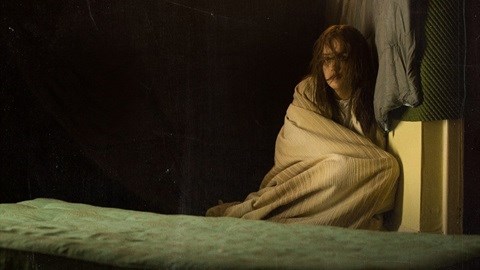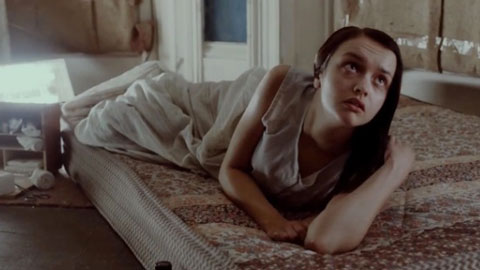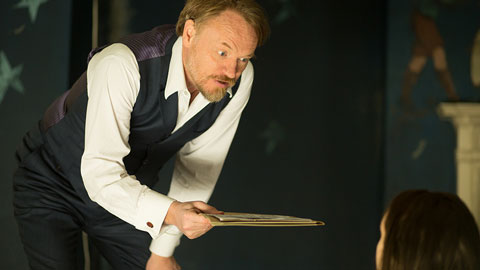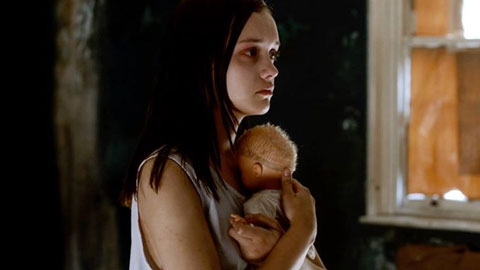The Quiet Ones Might sound meek and mild, but beware - it is one of the most terrifying films of the year and will shock you to the core. It's all and more that any full-blooded horror fan can expect from the producer who brought you The Woman In Black and Let Me In.
Few names have ever sparked as much tantalising fear and dizzying horror as Hammer. Starting in the 1930s the British film studio, Hammer Films, churned out one bone-chilling classic after another, from Gothic monster movies to zombie adventures to spooky occult thrillers. In 2008, the Hammer brand of horror was revived, with the company producing two of the freshest scary films of the new millennium: Matt Reeves' emotional twist on a contemporary vampire tale, Let Me In, and the ghost vengeance story, The Woman In Black. Now, Hammer takes a smart, stylish dive into one of horror's most alluring subjects - supernatural possession - with The Quiet Ones, inspired by true events that put rational science and the creepiest mysteries of the paranormal on a collision course.
The heart of what scares us most
The Quiet Ones plunges into the heart of what scares us most as it explores a series of experiments in 1970s' London on a deeply disturbed girl; an abandoned foster child rejected by every home that took her in because of the strange and alarming happenings following her. But what lies at the root of her extreme psychic disturbance? Is there a logical explanation for her eerie torment? Or is a team of researchers about to unleash a darkness they cannot hope to fathom or possibly survive?
This unnerving tale unfolds featuring superb performances from Jared Harris (Mad Men and Sherlock Homes: A Game of Shadows) as the impassioned scientist Professor Joseph Coupland, Olivia Cooke from Bates Motel as a young girl who harbours unspeakable secrets, and Sam Claflin (The Hunger Games: Catching Fire) as a documentary filmmaker who is not a scientist nor a believer in the supernatural - he's just a guy doing a job, or so he thinks until he is pulled in deeper and deeper by his need to help the alluringly vulnerable Jane Harper.
Inspired by true events, the film is directed by John Pogue from a screenplay by Craig Rosenberg and Oren Moverman and John Pogue, and based on a screenplay by Tom de Ville.
The inspiration for The Quiet Ones began with an incredible history: real scientists probing such disquieting human experiences as hauntings, clairvoyance, psychokinesis and even teleplasm (emanations from the body of a person with telepathic powers) - in medical-style laboratories. As screenwriter Tom de Ville delved into the heyday of paranormal research, there was one particularly jolting incident that grabbed him.
"It was an experiment conducted in the mid-1970s in Toronto," he explains. "The researchers were looking at the idea that poltergeists might be created by intense emotional energy and, to try to prove this, they set about trying to create a supernatural being from their own emotional energy."
The Phillip Experiment
Known as The Phillip Experiment, it was conducted under the auspices of Dr ARG Owen, a UK-born mathematician, geneticist and lecturer who wrote several papers on poltergeists and telekinesis. During the experiment, a small team conjured up a ghost named Phillip on paper - drawing his likeness, giving him certain qualities - then attempted to bring him to life using their collective concentration and emotional moods. At first nothing happened, but soon a series of unnerving happenings - raps and taps and shaking tables - convinced the team that some kind of psychic activity was truly in play. They even made a film, documenting part of the experiment.
This sent De Ville's imagination reeling into the possibilities. "I immediately wanted to expand this into a horror story, about people who chart a similar experiment - which then goes terribly wrong as they begin to lose control of the thing that they have created," he recalls.
Thus was born the character of Jane Harper, a darkly disturbed girl who has seemingly been channelling all her suppressed fury and distress into an entity known as Evey. But is Evey really just a creation of Jane's chaotic mind, or something far more dangerous and powerful?
"McNeil becomes our conscience, our eyes and ears, quite literally," says producer Ben Holden, who previously produced The Woman In Black for Hammer. "He's an outsider, a townie not a scientist, but as the film goes on he grows a voice and he begins to question just what they are all doing."
Those questions only grow more urgent as McNeil grows closer to Jane, becoming the one person she can trust - and the one person who senses that things are going terribly wrong in the experiment.
For director John Pogue these questions were the key to creating a possession thriller with a fun, modern edge. Pogue - best known as the screenwriter of US Marshals, The Skulls and Rollerball as well as the writer-director of Quarantine 2: Terminal - had himself studied experimental psychology in college. So, the idea of creating shock and fear from a team of experimenters convinced there is no scientific reason to be afraid struck him as very exciting territory.
The golden age of paranormal research
He was especially drawn to the story's 1970s roots - in the golden age of paranormal research, which led to some astonishing, and still unresolved, experiments before the programmes lost their funding and went deeper underground.
"In the 60s and 70s, several universities, including Princeton, started creating departments of parapsychology," he notes. "Our film takes place in 1974, at the height of interest in studying the paranormal. I felt it was a great foundation for a horror film because it brings in that unnerving element of reality."
A gripping realism - enhanced by the "found footage" effect of unfolding the story through the POV of a young, local filmmaker hired to document the experiment became the underpinning of Pogue's approach.
"We wanted to create something in the tradition of atmospheric, psychological, character-based horror," he says. "The idea was to pit the supernatural against science - with a lot of scares to rattle your thinking as to which is more believable."
For Pogue, the most devastating chills start with the dark questions at the back of the human mind, questions about what is real, what is imagined and what is so unsettling and confounding that it might not fit into either category.
"With the scares in the film, I took an approach that is a bit old school, in that we attempt to take the audience into certain places in their heads, where you're not quite sure what is really going on," he explains. "At first, you only see glimpses of things rather than the 'Full Monty' - that is, until events become increasingly horrific."
A whole new visual avenue
When Professor Coupland hires McNeil as a cameraman to document the Jane Harper experiment, it opens up a whole new visual avenue for the film - giving the filmmakers an opportunity to tell parts of the story through the camera's eye, and to create several retro-style films within the film.
"That was immediately appealing," says writer Tom de Ville, "the use of an in-camera and 'found footage' idea - but embracing 60s' and 70s' film technology, which is so clunky and evocative, where you get things like the film burning out at the end of a reel, or microphones that react with electronic fuzz, pops and bangs."
"McNeil's camera equipment contributes a lot to the film and adds a certain tactile quality," Ben Holden comments. "It looks beautiful on the screen and then equally the machinery that they rig up, the different devices that they use to harness all this negative energy and channel it, is very evocative - quite creepy and fun."
Working with innovative cinematographer Matyas Erdely (Miss Bala), Pogue was especially excited to have a chance to mix multiple film formats. "We're able to have that deep, rich, organic, saturated 16mm look that a lot of the great 70s' movies were shot in and then to mix in with that more of a classical storytelling mode," he says.
The two eventually opted to shoot the in-camera documentary footage digitally, using the Arri Alexa camera. "We realised that the best way to do this was to with the Alexa because of the richness that the image was giving us and because of its flexibility," Pogue explains.
Adding to the film's richness was the collaboration between Pogue, Erdely and production designer Matt Gant, who crafted the film's primary, isolated location: a creepy old house in Oxfordshire, England that provides the perfect backdrop to the experiment - replete with Jane Harper's mysterious, locked room.
Additional footage in the film dredges up Professor Coupland's personal history, harking back to one of his very first cases - that of David Q, a precursor to Jane Harper, whose treatment mysteriously ended abruptly.
Beyond science, beyond psychology
Pogue notes that the design of the entire production was aimed at exposing to the audience all the layers of what is going on with Coupland, McNeil and Jane Harper, as their journeys take them beyond science, beyond psychology, perhaps beyond what any of them can handle.
"Hopefully, as the audience is immersed deeper and deeper into McNeil's point of view, it will make what he and they are seeing that much more frightening," the director concludes.
Producer Simon Oakes, CEO and president of Hammer Films, says The Quiet Ones fits right in with the company's aim of savvy, modern horror for a 21st-century audience.
"When we announced that we had acquired Hammer and were going to bring it back from the dead, so to speak, inevitably a lot of scripts came in, but we were always searching for something intelligent, fascinating and very plot-driven," he says. "With The Quiet Ones we found a story inspired by something that really happened and it had all the elements of a stand-out horror thriller. Best of all, it is a film that hinges everything on psychological terror, which is always the scariest."
Read more about this film and other new releases at www.writingstudio.co.za.










































